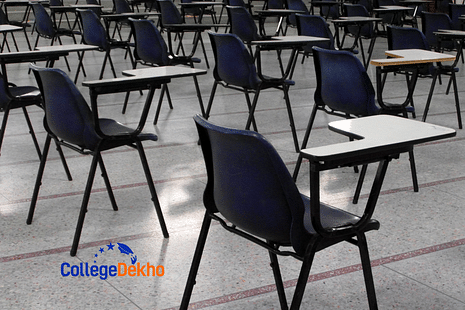
Difference Between WBJEE and JEE Main:
While preparing for engineering entrance exams in India, you should know about the two major exams namely, WBJEE and JEE Main. The difficulty level, eligibility criteria, syllabus, and exam pattern for both exams are slightly different. WBJEE and JEE Mains are two of the most sought-after engineering entrance exams. The WBJEE or West Bengal Joint Entrance Exam is a state-level exam held for admission to engineering colleges across West Bengal; on the other hand, the Joint Entrance Exam (JEE) is held on the national level for admissions to the IITs and NIT across the country. This article will discuss the main differences between the WBJEE and JEE Mains exams and how you should prepare for each.
Also Check -
WBJEE 2025: Application Form, Exam Dates, Eligibility, Pattern, Preparation
Difference Between WBJEE and JEE Main
The WBJEE exam is organized by the West Bengal Entrance Examination Board for students aspiring to join engineering colleges across West Bengal. The exam is held to provide admissions to undergraduate courses in engineering, technology, pharmacy, and architecture. You can enroll in various government and private engineering colleges in West Bengal through the WBJEE 2025 exam . The eligibility criteria generally require you to have completed your 10+2 education from a recognized school education board with at least 60% marks in aggregate and Physics, Chemistry, and Mathematics as compulsory subjects.
The JEE Main is a national-level engineering entrance examination organized by the National Testing Agency (NTA). The exam is held twice a year across India and provides an opportunity for you to get admission into prestigious technical colleges such as the Indian Institute of Technology (IIT) and the National Institute of Technology (NIT) along with other government and private colleges. You must have completed your 10+2 education from a recognized school board with at least 75% aggregate marks and Physics, Chemistry, and Mathematics as core subjects are eligible to appear in the exam. Once you clear the
JEE Main 2025 exam
, you are invited to appear in the JEE Advanced examination; only after passing the JEE Advanced examination, do you become eligible for the JEE counselling process.
Here are the key differences between WBJEE and JEE Main:-
| Particulars | WBJEE | JEE Main |
|---|---|---|
| Eligibility | Passed 10+2 with 60% aggregate marks and compulsory PCM subject combination | Passed 10+2 with 75% aggregate marks and compulsory PCM subject combination |
| No. of Attempts | No limit | Twice a year (for up to 3 consecutive years) |
| Admission | Government and private engineering colleges in West Bengal | IITs, NITs and other B.Tech colleges across India |
Quick Links:
| WBJEE 2025 Eligibility Criteria | WBJEE 2025 Exam Date |
|---|---|
| WBJEE 2025 Registration | WBJEE 2025 Admit Card |
| WBJEE 2025 Exam Centres | - |
WBJEE vs JEE Main Difficulty Level
Both JEE Main and WBJEE are important exams in the field of engineering. Although the WBJEE vs JEE Main difficulty level may vary depending on the overall competition and your preparation strategy and readiness, WBJEE is considered easier than the JEE Mains. This is majorly because of the level of questions asked in the examination is usually easy to moderate; only a few questions may seem tricky or difficult. Moreover, being a state-level examination, the number of takers for WBJEE is much lower in comparison to JEE Main. In 2024, approximately 1.42 lakh students appeared for WBJEE while over 12 lakh students took the JEE Main exam, suggesting that the competition for WBJEE seats is relatively low.
You can better understand the difficulty level of the WBJEE and JEE exams from the below:
| WBJEE vs JEE Main Difficulty Level | |
|---|---|
| WBJEE | JEE Mains |
| Easy to moderate level questions are typically asked | Moderate to tough questions are generally asked |
| Usually formula-based direct questions are asked | A combination of formula-based and conceptual questions may be asked to test your in-depth knowledge |
| 155 questions to be answered in 4 hours | 90 questions to be answered in 3 hours |
| Level of competition relatively low with approximately 1.5 lakh exam takers each year | Level of competition relatively higher with approximately 10-12 lakh exam takers every year |
WBJEE vs JEE Main Exam Pattern
Even though WBJEE and JEE are engineering entrance exams, they both have several differences that set them apart. In this section, we will discuss the difference between WBJEE and JEE exam patterns.
WBJEE Exam Pattern
The WBJEE 2025 exam pattern is set by the West Bengal Joint Entrance Examination Board and includes the pattern of the question paper. The WBJEE exam is held for a duration of 4 hours and includes three sections Physics, Chemistry, and Mathematics. The questions are asked in two mediums English and Bengali. The exam pattern provides for a total of 155 questions from three sections and a total of 200 marks. Let’s have a look at the WBJEE exam pattern in detail with the following table:
Particulars | Details |
|---|---|
Examination Mode | Offline (OMR) |
Duration of Exam | 4 Hours (2 hours for each paper) |
Subjects | Paper 1: Mathematics Paper 2: Chemistry & Physics |
Number of Questions | Physics: 40 Chemistry: 40 Mathematics: 75 |
Types of Questions | Multiple Choice Questions (MCQs) |
Marking Scheme | Category 1: Each correct answer carries 1 mark Category 2: Each correct answer carries 2 marks Category 3: Each correct answer carries 2 marks |
Negative Marking Scheme | Category 1: Deduction of 1/4 marks Category 2: Deduction of 1/2 marks Category 3: No negative marking |
Answer Mode | Four alternatives for each question Only one correct answer is to be selected and circled in the OMR sheet with a black/blue ballpoint pen |
Category-wise Division | Category 1:
Category 2:
Category 3:
|
WBJEE Total Marks | 200 marks |
| Medium of the Exam | English and Bengali |
JEE Exam Pattern
JEE exam is held twice a year, the exam has mainly three sections Physics, Chemistry, and Mathematics. The exam is held for 3 hours and a total of 90 questions are asked in the question paper. The JEE exam includes a total of 200 marks and there are negative marks awarded for each incorrect answer. In the following table, we have compiled the complete JEE Main 2025 exam pattern :-
Particulars | Details |
|---|---|
Exam Mode | Online (Computer based) |
Number of Sections and Subjects | 3 (Physics, Chemistry, and Mathematics) |
Duration of Exam | 3 hours (180 minutes) |
Type of questions | MCQs: 4 options with only 1 correct option Numerical Value Questions: Questions whose answers are to be filled in as a numerical value |
Section A (MCQ) |
Mathematics: 20
|
Section B (Numerical Value) |
Mathematics: 10
In Section B, students have to attempt any five questions out of 10 from each section. |
How Many Questions in JEE Mains | 90 |
JEE Main Total Marks | 300 marks |
Language of paper | Assamese, Bengali, Kannada, Malayalam, Marathi, Odia, Punjabi, Tamil, Telugu, Urdu, Hindi, English, Gujarati |
Quick Links:
| WBJEE 2025 Exam Preparation Tips | Best Books for WBJEE 2025 Exam Preparation |
|---|---|
| WBJEE Previous Year Question Papers | WBJEE Sample Papers |
| WBJEE 2025 Mock Test | Best WBJEE Coaching Institutes in India 2025 |
WBJEE vs JEE Main Syllabus
The WBJEE and JEE exams follow a similar syllabus; both exams feature topics from classes 11th and 12th Physics, Chemistry, and Mathematics. However, the WBJEE exam is also conducted for admission to B.Pharma courses. While preparing for both exams, you should carefully read the complete syllabus and plan their studies accordingly. Let’s have a detailed look at the WBJEE and JEE syllabus from the table below:-
Subject | JEE Topics | WBJEE Topics |
|---|---|---|
Physics | Physics and Measurement | Physical World, Measurements, Units & dimensions |
Kinematics | Kinematics | |
Laws of Motion | Laws of Motion | |
Work, Energy, and Power | Gravitation | |
Rotational Motion | Friction | |
Gravitation | Surface tension | |
Properties of Solids and Liquids | Bulk properties of matter | |
Thermodynamics | Viscosity | |
Kinetic Theory of Gases | Kinetic theory of gases | |
Oscillation and Waves | Thermodynamics | |
Electrostatics | Current Electricity | |
Current Electricity | Oscillations & Waves | |
Magnetic Effect of Current and Magnetism | Electrostatics | |
Electromagnetic Induction and Alternating Current | Magnetic effect of current | |
Electromagnetic Waves | Electromagnetic induction & alternating current | |
Optics | Magnetics | |
Dual Nature of Matter and Radiation | Electromagnetic waves | |
Atoms and Nuclei | Nuclear Physics | |
Electronic Devices | Solid State Electronics | |
Optics I (Ray optics) | ||
Optics II (Wave Optics) | ||
Chemistry | Atomic Structure | Atomic Structure |
Chemical Bonding and Molecular Structure | The Periodic Table and Chemical Families | |
Chemical Thermodynamics | Radioactivity and Nuclear Chemistry | |
Solutions | Coordination Compounds | |
Equilibrium | Chemical Bonding and Molecular Structure | |
Redox Reactions and Electrochemistry | Solid State | |
Chemical Kinetics | Liquid State | |
Classification of Elements and Periodicity in Properties | Gaseous State | |
p-block elements | Chemical Energetics and Chemical Dynamics | |
d- and f-block elements | Physical Chemistry of Solutions | |
Coordination Compounds | Ionic and Redox Equilibria | |
Hydrogen | ||
Chemistry of Non-Metallic Elements and their Compounds | ||
Chemistry of Metals | ||
Chemistry in Industry | ||
Polymers | ||
Surface Chemistry | ||
Chemistry of Carbon Compounds | ||
Environmental Chemistry | ||
Compounds | ||
Alcohols | ||
Aromatic Compounds | ||
Application Oriented chemistry | ||
Principles of Qualitative Analysis | ||
Mathematics | Sets, Relations, and Functions | Algebra |
Complex Numbers and Quadratic Equations | Logarithms | |
Matrices and Determinants | Complex Numbers | |
Permutation and Combination | Quadratic Equations | |
Binomial Theorem and its Simple Applications | Matrices | |
Sequence and Series | Permutation and combination | |
Limit, Continuity and Differentiability | Principle of mathematical induction | |
Integral Calculus | Binomial theorem | |
Differential Equations | Sets, Relations, and Mappings | |
Co-ordinate Geometry | Statistics and Probability | |
Three Dimensional Geometry | Trigonometry | |
Vector Algebra | Two dimensions Coordinate geometry | |
Statistics and Probability | Three dimensions Co-ordinate geometry | |
Trigonometry | Vectors | |
Differential Equations | ||
Integral calculus | ||
Differential calculus |
Quick Links:
WBJEE and JEE Main Common Topics
Several WBJEE and JEE topics are common for both exams. In the following table, we have compiled all the common topics from the WBJEE and JEE syllabi.
Subject | Common Topics/Subject |
|---|---|
Physics | Physics and Measurement |
Kinematics | |
Laws of Motion | |
Gravitation | |
Thermodynamics | |
Kinetic Theory of Gases | |
Electrostatics | |
Current Electricity | |
Magnetic Effect of Current and Magnetism | |
Electromagnetic Induction and Alternating Current | |
Optics | |
Chemistry | Atomic Structure |
Chemical Bonding and Molecular Structure | |
Coordination Compounds | |
p-block elements | |
d- and f-block elements | |
Equilibrium | |
Mathematics | Complex Numbers and Quadratic Equations |
Algebra | |
Matrices and Determinants | |
Quadratic Equations | |
Sequence and Series | |
Sets, Relations, and Mappings | |
Co-ordinate Geometry | |
Trigonometry | |
Statistics and Probability |
No matter which of the two exams you are opting for, make sure you are aware of the differences between WBJEE and JEE Main in terms of the difficulty level, syllabus topics, exam pattern and other aspects. Go through the various WBJEE study materials and section-wise syllabus breakup on our page as you prepare for the upcoming session!
Related Articles
For more WBJEE articles and the latest news and exam updates, stay tuned to CollegeDekho!Are you feeling lost and unsure about what career path to take after completing 12th standard?
Say goodbye to confusion and hello to a bright future!

Was this article helpful?


















Similar Articles
Rajasthan Polytechnic Admission 2025 - Dates, Application Form, Eligibility, Merit List, Option Form
BTech Admission through COMEDK Counselling 2025: Mock Allotment (Out), Seat Allotment, Document Required
DTE Rajasthan Polytechnic Seat Allotment List 2025: Direct Link, Fees
MP B.Arch Admission 2025 - Dates (Out), Entrance Exam Accepted, Process, Documents
Madhya Pradesh M.E/M. Tech Admission 2025: Dates (Out), Eligibility Criteria, Application Form, How to Apply
CSAB Counselling Registration 2025: Dates, Documents Required, Fees, Step-by-Step Form Filling Process